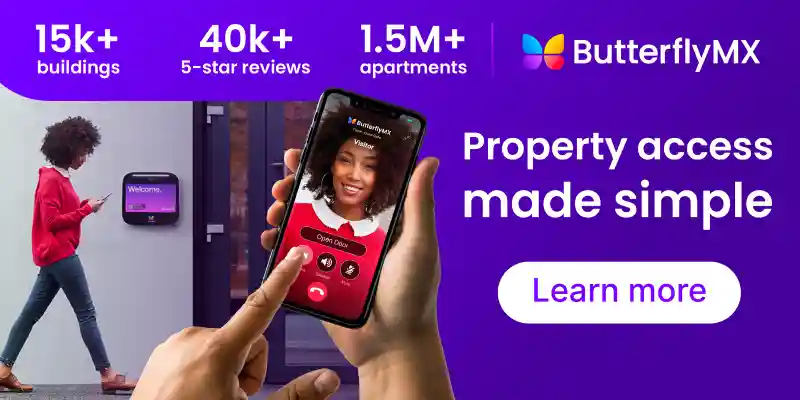Key takeaways
- Nonprofits face unique security challenges; balancing openness with safety requires access control systems that are both secure and easy to use.
- Modern access control solutions qualify for FEMA’s Nonprofit Security Grant Program 2025, making it easier to upgrade without straining your budget.
- Video intercoms, keypads, cameras, and front desk stations are the most effective ways to secure your facility while keeping operations simple for staff and volunteers.
- Cloud-based systems scale with your mission, ensuring your nonprofit is protected today and ready for tomorrow’s growth.

Nonprofits exist to serve their communities. But protecting the people, property, and mission behind that service is just as important as the work itself. From staff and volunteers to members and visitors, every nonprofit facility welcomes a wide range of people through its doors each day. That openness is what makes these organizations vital, but it also creates unique security challenges.
That’s where access control comes in. Modern systems like video intercoms, keypads, security cameras, and front desk stations give nonprofits the tools to safeguard their spaces while keeping entry welcoming and convenient. And thanks to funding opportunities like FEMA’s Nonprofit Security Grant Program 2025, organizations don’t have to shoulder the cost of upgrading security alone.
In this guide, you’ll explore what nonprofit organization access control is, why it matters, the types of systems available, and how your organization can use grant funding to create a safer environment for everyone you serve.
Navigate this post:
- What is nonprofit access control?
- Types of access control systems for nonprofits
- The 4 access control types and 5 access control components explained
- Funding security upgrades: FEMA Nonprofit Security Grant Program 2025
- Best practices for nonprofit access control
- Pros and cons of modern nonprofit access control systems
- How to choose the right solution for your nonprofit
- Nonprofit access control FAQs
What is nonprofit access control?
Nonprofit access control refers to the systems and processes that regulate who can enter your organization’s buildings and spaces and under what conditions. For nonprofits, this often means balancing openness with protection. You want to remain accessible to staff, volunteers, donors, and community members while ensuring unauthorized individuals can’t gain entry.
Unlike private businesses or government facilities, nonprofits often have limited resources and diverse visitor traffic, which makes traditional locks and keys harder to manage. Lost keys, frequent staff turnover, and the need to quickly grant or revoke access for volunteers can strain already tight budgets and operations.
That’s why many nonprofits are adopting modern, cloud-based access control systems.
These solutions make it possible to:
- Grant or revoke access instantly from a secure online dashboard.
- Monitor every entry event with time- and date-stamped photos.
- Simplify access for trusted partners and delivery drivers without compromising security.
With the right access control framework in place, nonprofits can protect their property, provide peace of mind to staff and members, and reinforce the credibility of their mission.
Types of access control systems for nonprofits
Every nonprofit has different needs depending on its size, mission, and facility type. A community center with daily visitors, for example, faces different challenges than a small administrative office or a faith-based organization. Fortunately, access control technology can be tailored to fit any environment.
Here are the most common systems nonprofits use:
Video intercom systems
A video intercom lets staff visually confirm visitors before granting entry. For nonprofits, this adds an extra layer of safety by ensuring only authorized individuals, such as volunteers, members, or delivery personnel, can access the building. Modern systems like the ButterflyMX Video Intercom work from a smartphone, so administrators can manage entry whether they’re on-site or remote.
Keypads & mobile access
Keypads are a cost-effective way to replace traditional keys. Staff, volunteers, and vendors can be assigned unique PIN codes, while mobile credentials allow entry directly from a smartphone. Both options eliminate the hassle of rekeying locks and reduce the risk of lost or stolen keys.
Security cameras
Cameras positioned at entry points and throughout facilities give nonprofits 24/7 visibility. They not only deter potential threats but also provide recorded evidence in case of incidents. ButterflyMX Security Cameras integrate directly with access control systems, so property managers can view live or recorded footage from the same platform they use to manage doors and gates.
Front desk stations
For nonprofits that staff a reception area or welcome desk, the Front Desk Station creates a centralized hub to manage all visitor interactions. Staff can see, speak with, and grant access to guests from a secure workstation, making it easier to balance hospitality with safety.
The 4 access control types and 5 access control components explained
When researching access control, you’ll often see references to the “four types” or the “five components” of access control. While these frameworks are commonly used in cybersecurity, they also apply to physical security systems, especially for nonprofits that need to carefully manage who can enter their facilities.
The four types of access control
- Discretionary access control (DAC). Access is granted at the discretion of the property owner or administrator. For example, a nonprofit director who is deciding who receives a keypad code.
- Mandatory access control (MAC). Access is determined by strict policies, often used in government or highly secure facilities. Nonprofits may use MAC for sensitive areas, such as medical records rooms.
- Role-based access control (RBAC). Permissions are tied to a person’s role. For instance, staff may have 24/7 building access, while volunteers can only enter during program hours.
- Attribute-based access control (ABAC). Access decisions are based on attributes, such as time of day, location, or other conditions. A nonprofit might use ABAC to allow delivery drivers access only during business hours.
The five components of access control
- Identification. Confirming who someone is (e.g., entering a PIN or scanning a credential).
- Authentication. Verifying that identity (e.g., matching the PIN or credential to a valid user).
- Authorization. Determining what areas they’re allowed to access.
- Access. Granting or denying entry at the door or gate.
- Monitoring. Keeping a record of every access event, often with time-stamped photos or video.
For nonprofits, these frameworks translate directly into everyday scenarios. Whether it’s limiting storage room access to staff, granting volunteers access only during events, or monitoring deliveries at the main entrance, understanding these models helps organizations design a security plan that’s both practical and compliant with funding requirements.
Funding security upgrades: FEMA Nonprofit Security Grant Program 2025
For many nonprofits, the biggest challenge to improving security isn’t deciding what to install; it’s figuring out how to pay for it. That’s where the FEMA Nonprofit Security Grant Program (NSGP) 2025 comes in.
The NSGP is a federal initiative designed to help nonprofits protect their people and property from potential threats. Each year, FEMA allocates funding that eligible organizations can apply for and use toward security enhancements, including access control systems, security cameras, and intercoms.
Navigate this section:
Who can apply?
- 501(c)(3) nonprofits at risk of terrorist attacks or hate crimes.
- Faith-based organizations, community centers, schools, and other nonprofits that serve the public.
What projects qualify?
- Physical security improvements, such as installing video intercom systems, keypads, or front desk stations.
- Technology upgrades like cloud-based security cameras.
- Training and exercises related to security awareness.
Key details for 2025
- FEMA typically releases the application guidance in the spring.
- The Nonprofit Security Grant Program 2025 deadline will fall shortly after guidance is issued, so organizations should prepare early.
- Strong applications align identified risks with specific security investments, making access control upgrades a high-impact choice.
Why it matters for nonprofits
This program makes it possible for nonprofits to upgrade their security without diverting limited funds away from their mission. By securing grant funding, organizations can implement systems like ButterflyMX Video Intercoms or Keypads that not only improve safety but also streamline day-to-day operations.
Disclaimer: This content is provided for informational purposes only and should not be considered legal, financial, or compliance advice. For official guidance on eligibility, applications, and deadlines, please refer directly to FEMA and the Department of Homeland Security.
Best practices for nonprofit access control
Installing access control technology is only part of the equation. To get the most out of your investment and to meet grant compliance requirements, nonprofits should also focus on building strong security practices.
Nonprofit access control best practices include:
- Train staff and volunteers. Even the best system only works if people know how to use it. Provide simple training for staff and volunteers on how to grant access, manage visitor policies, and respond to security alerts.
- Establish a clear access policy. Define who should have access, when, and to which areas. For example, volunteers may only need access during program hours, while staff require 24/7 access to offices. Putting these rules in writing prevents confusion and ensures accountability.
- Work with certified installers. Partnering with experienced integrators ensures your system is installed correctly, configured to your needs, and set up for future scalability. Installers can also help align your project with grant requirements if you’re applying for FEMA funding.
- Choose cloud-based, scalable solutions. Nonprofits often face staff turnover, fluctuating volunteer numbers, and seasonal events. A cloud-based platform makes it easy to adjust permissions in real time, monitor activity remotely, and expand the system as your organization grows.
Pros and cons of modern nonprofit access control systems
Upgrading to modern access control offers significant advantages for nonprofits, but it’s important to understand both the benefits and the challenges before investing.
Pros
- Enhanced safety. Systems like video intercoms and security cameras deter unauthorized visitors and allow staff to verify who’s entering before granting access.
- Grant eligibility. Access control upgrades are an approved use of FEMA’s Nonprofit Security Grant Program funding, making them more financially accessible.
- Operational efficiency. Cloud-based dashboards let administrators manage access remotely, revoke permissions instantly, and avoid the costs of rekeying locks.
- Better visitor experience. Mobile credentials, PIN codes, and intercom calls make it simple for staff, volunteers, and guests to enter without friction.
Cons
- Upfront costs. Even with grants, nonprofits may need to budget for installation and integration expenses.
- Training needs. Staff and volunteers will require some orientation to use the system properly.
- Legacy system integration. Older infrastructure may need updates to fully support modern, cloud-based solutions.
For most nonprofits, the long-term benefits outweigh these challenges, especially when grant funding offsets initial costs. The result is a system that strengthens security, improves operations, and helps build trust with the community you serve.
How to choose the right solution for your nonprofit
Every nonprofit is unique, which means the best access control system for one organization may not be the right fit for another. The key is to evaluate your security needs, budget, and operational priorities before making a decision.
How to choose the right access control and security solution for your nonprofit:
- Assess your risks and facility type. Start with a vulnerability assessment. Do you operate a community center with frequent visitors, or a small administrative office with limited foot traffic? Facilities with higher public access may benefit most from video intercoms and security cameras, while smaller spaces might only need keypads or mobile credentials.
- Consider your staff and volunteer base. High turnover among staff and volunteers can make physical keys impractical. A cloud-based access control system lets you instantly issue or revoke permissions without rekeying locks, saving both time and money.
- Plan for scalability. Many nonprofits grow over time, adding programs, staff, and facilities. Look for a system that can expand with you. With ButterflyMX, you can start with a video intercom at your main entrance and later add keypads, cameras, or front desk stations as your needs evolve.
- Leverage available funding. If you’re applying for the FEMA Nonprofit Security Grant Program 2025, align your project scope with allowable expenses. Access control devices like intercoms, keypads, and cameras are eligible, making it easier to implement the right solution without straining your budget.
Nonprofit access control FAQs
- Can nonprofits use the FEMA Nonprofit Security Grant Program for access control?
- Which access control systems are best for nonprofits?
- Can a nonprofit have a controller?
Can nonprofits use the FEMA Nonprofit Security Grant Program for access control?
Yes. Access control systems, including intercoms, keypads, and cameras, fall under allowable expenses in FEMA’s Authorized Equipment List (AEL). However, applicants must show how these upgrades address identified security risks.
Which access control systems are best for nonprofits?
The best systems combine safety with simplicity. Cloud-based video intercoms, keypads, security cameras, and front desk stations are especially effective because they’re easy for staff and volunteers to manage, scale as your organization grows, and qualify for grant funding.
Can a nonprofit have a controller?
Yes, but the term “controller” usually refers to a financial officer responsible for accounting oversight. This is different from an access control system controller, which manages physical security devices like intercoms and keypads.

Get your free quote!
Fill in the form below, and we'll email you right back.
Want a free quote?
Fill in the form below, and we'll email you right back.
You’ll be redirected shortly...






